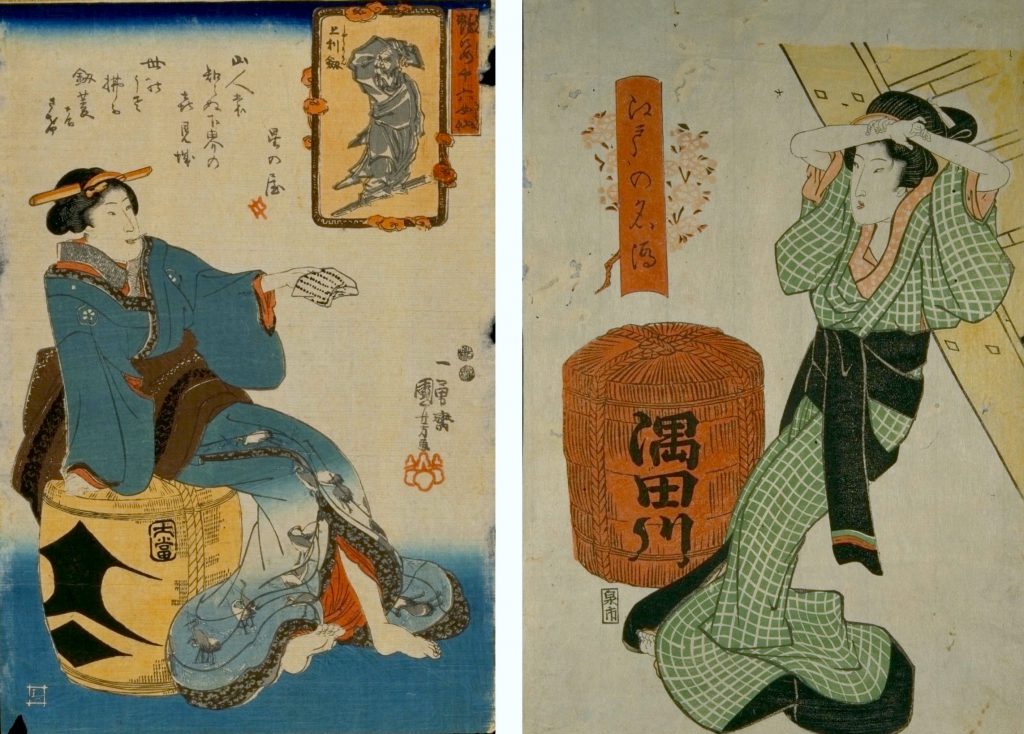Previous Article
Ginzuru Monotachi

When you hear the term ‘sake’ and ‘advertisement’ the first thing that comes into your mind might be ‘sakabayashi’. A ‘sakabayashi’ is a ball made from trimmed Japanese cedar branches, also called ‘sugidama’. It is a symbolic sign made by sake breweries to inform the public that their new brew is ready. This culture of advertisement began in the Muromachi period. However, sake shops and izakaya establishments continue to display them today. As with ‘sugibayashi’, signboards and ‘noren’ curtains are the most fundamental advertisements.
The widespread use of advertisements targeting the general public became more common in the second half of the Edo period. In the mid-18th century, mass culture and the commodity economy developed greatly. During this time, a large quantity of sake was shipped from western regions such as Ikeda, Itami, and Nada, all the way to Edo by cargo vessels called ‘tarukaisen’. Sakes from these regions were termed ‘kudari-zake’, and popular ‘kudari-zake” brands such as ‘Kenbishi’, ‘Otokoyama’, and ‘Shirayuki’ dominated the capital’s sake market. Sake made in Edo called ‘Jimawari-zake’ was also available through brands such as ‘Sumidagawa’ and ‘Miyakodori’. However, high-quality kudari-zake was overwhelmingly popular among the people of Edo.
During this period, sake breweries did not need to use advertisements as sake was already popular. However, the developing commodity economy resulted in differentiation and competition among sake brands. In addition, the surfacing of brand imitations urged sake breweries to strengthen their branding to differentiate from the fakes. Compared to medicine and cosmetics, sake is a luxury item that lacks the components and effects to appeal to general consumers. Therefore, enhancing the brand’s reputation, especially the locality and the trademark of the sake was of the utmost importance. It can be said that advertisements existed to build these brands.
So how did breweries advertise their sake during the Edo period, a time when mass media was yet to exist? All sake breweries used a 72-liter cask called ‘shitodaru’ to transport their sake. A woven straw mat called ‘komo’ was also wrapped around this cask. Sake breweries printed their trademark on this komo to differentiate their sake brand. This ‘packaging’, also known as ‘komodaru’ can be considered the first advertisement of sake.
Komodaru with printed trademarks appear in many popular ‘Nishiki-e’, or multi-colored ukiyo-e, especially in works featuring famous actors, ‘Yakusha-e’, and beauties, ‘Bijin-e’. It was also drawn on the back-cloth of Kabuki stages, on printed sake rankings, and even in board games such as sugoroku. In addition, sake breweries stacked and displayed their komodaru at public gatherings such as religious events, festivals, and celebrations to advertise their brand to the mass public. Through utilizing different ideas and strategies, sake breweries built their brand’s reputation.
Image no.1 below is a Bijin-e advertising ‘Kenbishi’, a representative sake brand of ‘kudari-zake’. Meanwhile, image no.2 is a Bijin-e that casually includes the kodomaru of ‘Sumidagawa’ a representative sake brand of ‘jimawari-zake’. Image no.2, with “Supreme Sake of Edo” written above the komodaru, appears to be an advertisement created against the popular ‘kudari-zake’ of image no. 1. People of the Edo period began employing advertisement tactics that resemble the brand-building strategies we see today.

When Japan entered the Meiji and Taisho period, people’s love for Ukiyo-e also shifted to ‘‘Bijin-ga Posters’ depicting beautiful women. The tradition of Ukiyo-e wood prints was replaced by lithography, and this soon became an effective medium for advertisement. Renowned artists such as Tsunetomi Kitano and Hokuu Tada created famous Bijin-ga that was used on sake advertising posters and mesmerized the public.
In the late Showa period, the methods of advertising sake diversified. However, the tradition of Bijin-ga continued as the classical approach. Beautiful actresses were frequently used in advertisements for sake and rival companies appointed highly appreciated actors to compete with them. This strategy leads to the form of ‘celebrity communication’ that stimulates the public by showing their favorite celebrities enjoying a glass of sake that we see today.
Yoshiyuki Sakaguchi (Ad Museum Tokyo, Curator)